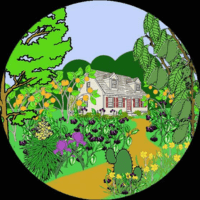Spikenard - American (Aralia racemosa) and Japanese (Aralia cordata)
Spikenard is a soft-stemmed large leafed beauty! She thrives in shade, and is easy to care for. And, they have edible and medicinal qualities!
We highlight the differences and similarities of the American and Japanese Spikenard. What parts are eaten is the main difference.
American Spikenard (Aralia racemosa) has a long history with Native American. Six Native American tribes had approximately 50 documented uses of Aralia racemosa. One the other hand, farming Japanese Spikenard (Aralia cordata) is a serious business in Japan. It’s grown for its young shoots. In Japan, the plant is called Udo (ウド), and is also grown in tunnels (Nanka Udo)! Throughout Asia, Japanese Spikenard shoots are a popular vegetable.
Care and propagation is easy. Shade and adequate moisture are the only considerations. Overall, Spikenard is an attractive specimen plant!
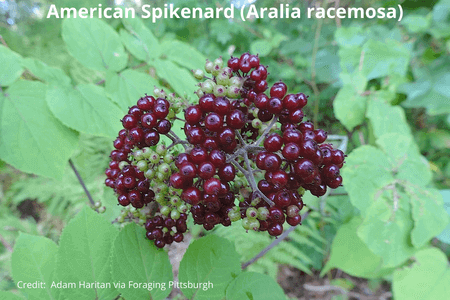
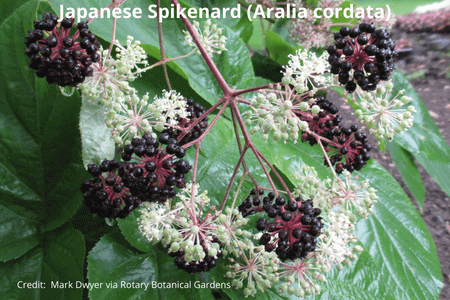
Spikenard Plant Guide on ONE webpage!
Plant guide for Aralia racemosa and Aralia cordata
- The Difference between American (Aralia racemosa) and Japanese (Aralia cordata) Spikenard
- Fact Sheet for American & Japanese Spikenard
- Spikenard in YOUR Garden — attractive attributes of an edible plant
- Edible and Medicinal Spikenard
- Spikenard Care and Propagation
- Aralia ‘Sun King’
- Spikenard Growing in our Garden
________________________________________
check-out our list of 400 edible plants
YouTube channel (please subscribe)
YouTube playlist for Spikenard
What's the difference: American Spikenard vs. Japanese Spikenard
they are very similar but are not ;).
Similarities - American & Japanese Spikenard
- Attractive. large luscious leaves that grow off soft stems. ONE plant will fill-in a sizable area. also, the fruit’s red, purple or black colored berries contrast beautifully against the plant’s large, green leaves.
- Wildlife food. spikes of very small flowers (panicles) develop in late summer. their flowers develop into pleasant looking berries (drupes). and birds thrive on the berries.
- Shade tolerant. they grow as understory plants in moist or temperate forest. however, both varieties of Spikenard tolerate full sun in cooler climates. we are planting both varieties in a location with shade through most of the day (zone 7). they’ll get sunlight late-day.
- Erosion control. both self-seed and grow rhizomes to form thickets. however, it’s not aggressive.
- Food. young shoots, young leaves and roots are consumed.
- Disease & Pests. both are disease free (leaf spot is rare cases). Pests will include aphids, mealybugs, spider mites, slugs, and snails.
Dissimilarities - American & Japanese Spikenard
- Caution. do NOT eat the berries from the Japanese Spikenard (Aralia cordata). information is NOT clear as to why. there is conflicting information. however, better safe than sorry so HEPPY™ recommends not eating the berries.
- Food. berries from the American Spikenard (Aralia racemosa) are be eaten (Plants for a Future).
- Food. young shoots from the Japanese Spikenard (Aralia cordata) is a SERIOUS food item in Japan.
- Height. the Japanese variety is slightly taller than the American (6′ vs. 5′, respectively).

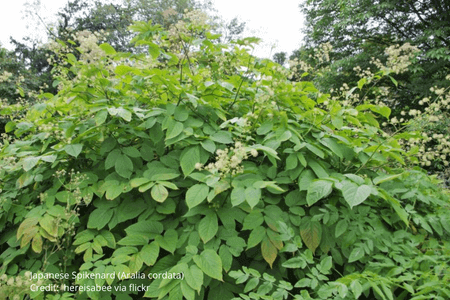
Spikenard Fact Sheet
American Spikenard, Aralia racemosa
Aralia racemosa is also known as Small Spikenard, Indian Root, Spice Berry, Spignet, Life-of-man, and Petty Morel.
it is native to North America. Aralia racemosa grows native in most U.S. States and the Eastern half of Canada.
Zone: 3 to 8
Height: 3 to 5 feet
Self-fertile: yes
Sun: full sun to part shade (dapple light in hot climate)
Water: medium
Soil: forgiving, but prefers fertile, humusy loams
Suggested Use: food, specimen plant, erosion control, shady locations.
Deciduous or evergreen: deciduous
Family / Genus: Araliaceae / Aralia
Japanese Spikenard, Aralia cordata
Aralia cordata is also known as Mountain Asparagus or Udo. it is a valued food in Japan. Nanka Udo (grown in tunnels) and Yama Udo (wild, greenhouse, etc.).
it is native to China, Japan and Korea. Aralia cordata grows in shady parts of forested areas and grassy slopes.
Zone: 4 to 8
Height: 3 to 6 feet
Self-fertile: yes
Sun: full sun to part shade (dapple light in hot climate)
Water: medium
Soil: forgiving, but prefers fertile, humusy loams
Suggested Use: food, specimen plant, erosion control, shady locations.
Deciduous or evergreen: deciduous
Family / Genus: Araliaceae / Aralia
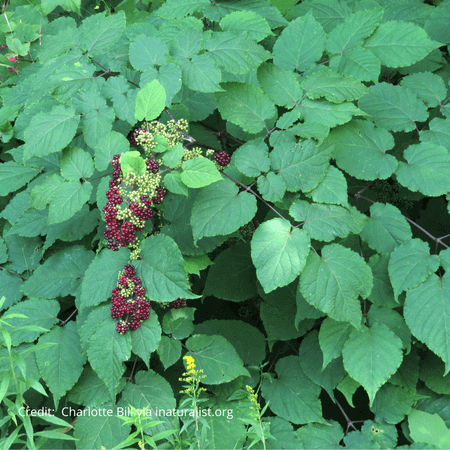

Spikenard in YOUR Garden - Pleasant Attributes
Spikenard grows well in shaded areas. “sundappled shade” in warmer climates and full sun in cooler climates are ideal conditions. by nature, the American and Japanese Spikenard grow in moist woodlands, thickets, and prairies.
it’s a great looking plant that’s easy to maintain. Spikenard is an erect, soft-stemmed plant. it grows compact and displays broad leaves. in July-September it develops 1-2 foot stems of small white flowers (panicles). American Spikenard (Aralia racemosa) flowers develop reddish or burgundy berries (drupes). Japanese Spikenard (Aralia cordata) flowers develop dark purple or black berries. overall, this plant that’s easy to prune and maintain.
it’s size and shape will fill-in a space nicely. one plant can cover a large space. therefore, it’s an excellent single specimen plant, grown in clusters of 2-3 plants, edges of a rain garden, naturalized areas, wild gardens, and native plant gardens.
avoid locations with frequent strong winds. she’s soft-stemmed with big leaves :).
they self-seed and spread by rhizomes. that’s a positive attribute for erosion control. however, some care may be needed; in optimal conditions, you’ll have little Spikenard plants to pot and sell ;). we prune-off flower heads of plants that self-seed. Garlic Chives, Allium tuberosum is the best example of an aggressive self-seeding plant. simply remove flowerheads after bloom and before seeds mature.
it is REPORTEDLY deer resistant. we’re yet to test deer resistance at HEPPY™. our deer are cute assh&%@s that even nibble on Spicebush.
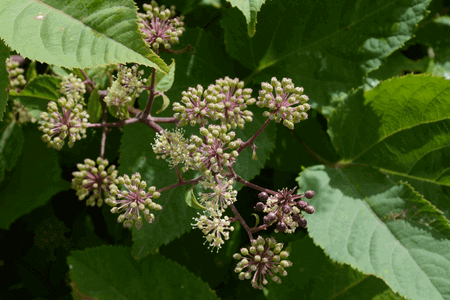
Edible and Medicinal Spikenard
1 HEPPY cannot take any responsibility for any adverse effects from the use of plants. Always seek advice from a professional before using a plant for food or medicinally. This information is intended for educational purposes only and should not be considered as a recommendation or an endorsement of any particular medical or health treatment.
Eating Spikenard¹
American Spikenard (Aralia racemosa)
berries, young shoots and roots are eaten.
Aralia racemosa berries are edible. most sources write that the raw berries have a pleasant taste. a trusted source — Missouri Botanical Garden — writes that the berries are “inedible.” we’re about to find out at HEPPY™ because our Aralia racemosa are blooming (Sept 2022).
young shoots are used as an herb in cooking, such as flavoring in soups.
roots are described as “Large and spicy, it is used in soups[43, 105, 161, 177]. Pleasantly aromatic, imparting a liquorice-like flavour[183]. A substitute for sarsaparilla (Smilax spp.)[200], it is also used in making ‘root beer'[183]” (Plants for a Future). authors Merritt Fernald & Alfred Kinsey wrote that the Menomini Indians cooked the root with wild onion, wild gooseberry and sugar for a “fine dish.” however, research shows that Native Americans used the roots for many medicinal purposes (Native American Ethnobotany). moreover, there’s very little information on how to prepare the roots. because of this, HEPPY™ recommends that you avoid eating the roots.
Japanese Spikenard (Aralia cordata)
CAUTION: do NOT eat Japanese Spikenard (Aralia cordata) berries. information about the berries’ safety is NOT clear. there is conflicting information. better safe than sorry so HEPPY™ recommends not eating the berries. more about what I found is here.
however, young shoots are WIDELY eaten in Asia. Aralia cordata roots are eaten too but must be properly prepared.
in Japan, Aralia cordata is called Udo (ウド).
young shoots are a culinary delicacy in Japan. shoots taste like asparagus. there’s Yama Udo (mountain udo) and Nanka Udo (softened udo). Yama Udo is foraged or grown in greenhouses. Nanka Udo is cultivated in underground tunnels to extend the growing season, and maximize size, flavor and texture. Udo is eaten in salads (独活), in soups, pickled, sautéed, and as tempura (lightly battered and deep fried to create a light, crispy coating).
this York Times. June 7, 1914 article is often cited (like, on Wikipedia): “raw stems are coated in a resin tasting similar to pine. Prior to eating, they should be thinly sliced and boiled in water a few times or placed in chilled water for an hour to eliminate the resin.”
leaves were found to have “a significantly high total phenolic content and antioxidant effect in all antioxidant capacity assays.“
white fleshy roots are eaten similarly to parsnip. however, they must be properly prepared. overall, there’s very little information on how to prepare the roots. because of this, HEPPY™ recommends that you avoid eating the roots.
in Korea, Aralia cordata is called ttangdureup (땅두릅).
in Korean cuisine, the shoots are commonly eaten blanched, pickled, pan-fried, grilled, or in soups and stews.
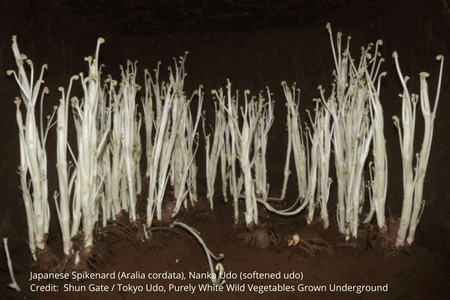
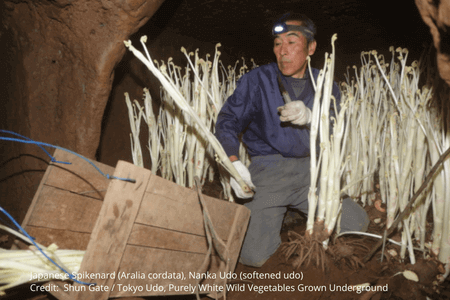
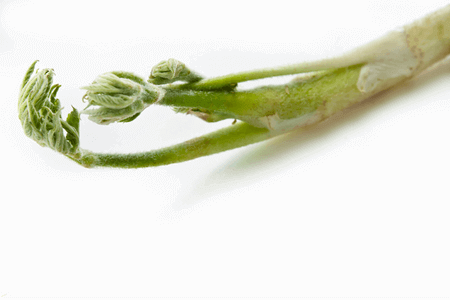
Medicinal use by Native Americans
at least 6 Native American tribes used American Spikenard, Aralia racemosa.
the Cherokee used a poultice of root ooze (from beaten roots) as wash for burns, on swellings, fresh wounds, and cuts. the Cherokee used a poultice of root ooze (from beaten roots) as wash for burns, on swellings, fresh wounds, and cuts. it was used for lung diseases, asthma, antiseptic, as a tonic, and for menstrual problems.
overall, six Native American tribes had approximately 50 documented uses of American Spikenard (Aralia racemosa).
Medicinal use in Asian Culture
Chinese, Japanese and Korean cultures used Japanese Spikenard (Aralia cordata) in traditional medicine.
- in China, “The root of the A. cordata plant is used for lumbago, rheumatism, and lameness in traditional Chinese medicine.”
- in Japan, I have emailed NPO Japan Medical Abstracts Society and Japan Society for Oriental Medicine (JSOM) for information on the traditional use of A. cordata.
- in Korea, the dried root has been traditionally used as medicine to treat inflammation, fever and pain (Wikipedia)
Clinical Research
American Spikenard (Aralia racemosa)
HEPPY™ cites studies found on NIH/PubMed. there are other sources; assume NIH/PubMed publication unless stated otherwise.
Anticancer:
there’s two studies about anticancer / antitumor properties. what’s NOT clear is what parts of the plant were used.
- from Planta Medica: Antitumor Activity of Aralia racemosa.
An extract of Aralia racemosa (aerial parts) showed cytotoxic activity against the MCF-7 breast tumor cell line. - from MedCrave Group: Anticancer activity of isolated constituents from Aralia racemosa L ….
Conclusion: Ursolic acid from Aralia racemosa L and Caffeic acid from Argyreia pilosa Wight & Arn has been showed anticancer activity SCC–29B and Ishikawa cancer cell line has been showed potent anticancer activity.
Fertility:
Aralia racemosa roots has been study “as potential fertility enhancers” (Table 2, Herbal fertility treatments used in North America from colonial times to 1900, and their potential for improving the success rate of assisted reproductive technology).
Promising attributes:
“A. racemosa, traditionally utilized in conventional medicines has incredible therapeutically potential due to its multifaceted biological functions.”
Japanese Spikenard (Aralia cordata)
HEPPY™ cites studies found on NIH/PubMed. there are other sources; assume NIH/PubMed publication unless stated otherwise.
no study provides clear conclusions. Aralia cordata is researched for ‘potential’ benefits and treatments.
- potential: might have a therapeutic role in the “prevention and treatment of neurodegeneration in stroke.”
- potential: “A. cordata may have a therapeutic role in preventing the progression of Alzheimer’s disease.
A. cordata showed antidementia activities in mice: - good for rabbits with arthritis 😉: “results indicate that Aralia cordata showed cartilage protective effects … in the CIA rabbit model.“
BUT, this study illuminated the plant’s transitional use: “Aralia cordata has been used to alleviate symptoms of osteoarthritis (OA) in traditional medicine.”
Japanese Spikenard (Aralia cordata) berries: toxic or poisonous?
HEPPY™ recommends NOT eating the berries of Aralia cordata until there’s evidence they are safe.
i found comments on non-scientific webpages about A. cordata berries as “poisonous” and “may be toxic to humans.” HEPPY™ recommends better safe than sorry. HOWEVER, no evidence was provided as to why the berries are dangerous. Wikipedia and individuals seem to be citing each other, i suspect.
the conflicting information is between the latter and a NIH/PubMed publication titled, Aralia cordata Thunb. as a Source of Bioactive Compounds: Phytochemical Composition and Antioxidant Activity (“the Study”).
the Study (emphasis added):
- “aimed to determine the bioactive compounds and antioxidant capacity of different parts of A. cordata…with a comprehensive study of A. cordata root, stem, leaf, inflorescence, berry, and seed investigation….”
- “the berries are rich in proanthocyanidins, anthocyanins, ascorbic acid, and total sugar. Therefore, it is clear that morphological parts are rich in bioactive compounds, which may have health benefits.”
- “A. cordata stem and berries are an excellent source of anthocyanins….”
Anthocyanins possess antidiabetic, anticancer, anti-inflammatory, antimicrobial, and anti-obesity effects, as well as prevention of cardiovascular diseases (NIH/PubMed, Anthocyanidins and anthocyanins: colored pigments as food, pharmaceutical ingredients, and the potential health benefits).
conflicting information is unfortunate. be safe and don’t eat the berries of A. cordata. PLEASE provide any scientific evidence they are safe. we either dispel a possible issue of interne-group-think OR, learn with certainty that there are health risks.
Spikenard Care and Propagation
plant Spikenard in shade if you live in a hot climate, and keep the large-leaved, soft-stemmed plant out of frequently windy locations. and that’s about it!
General Care
Sun
this is an understory plant (she lives on the forest floor, under tall trees). with that in mind, think shade. HEPPY™ is located in zone 7. it gets REALLY hot in the summer. so our American and Japanese Spikenard are planted where they get direct sunlight for a few hours late-in-the-day.
Soil and Water
it adapts to many soils (“forgiving”). however, organically rich soils are best. generally, the pH level is not an issue for ‘forgiving’ plants such as Spikenard.
it’s an understory plant in deciduous forests so in nature, it will always receive a heavy load of leaf-fall in the Fall. leaves breakdown to create superb, organically rich soil. however, Spikenard grows rhizomally. my INTUITION is that roots will expand quicker in super rich, soft soil. so there’s a tradeoff, unless you’re growing Spikenard for erosion control alone.
the amount of water & moisture is SO dependent on soil and location. Spikenard can grow in poor soil but that likely requires more frequent watering. we invest in creating rich organic beds of soil. consequently, we water only on during hot spells such as late summer.
Propagation
root division is the easiest form of propagation of Spikenard.
Root Division / Root Cuttings
propagate Spikenard by root division. first, allow the plant to grow and spread its roots rhizomally. rhizomes are roots that spread laterally just under the soil-surface. then, generally, a plant will emerge from the rhizome root. those plants are commonly called, ‘suckers.’
take root cuttings in fall through early spring. select a sucker with a section of well-rooted rhizome (peak under the soil — don’t be shy!). replant the root cutting is a their permanent location or in pots. you’ll have a high survival rate if you correctly judge the soil (loose & organic) and moisture (dormant roots/plants don’t need much water, if any).
Seed
Spikenard berries develop in Fall. I recommend that you allow the fruit to fully develop (watch for birds) and simply sow the seeds. squish the fruit’s flesh to release the seed. perhaps rinsing the flesh off seeds will assure optimal contact with the soil. the seeds should germinate the following Spring.
cold stratify seeds for no less than 3 months if you’re storing them. three months of cold stratification replicates its natural cycle.
Aralia 'Sun King'
the Sun King plant is a cultivar of the Japanese Spikenard, Aralia cordata.
it appears to be the most common variety of Aralia cordata sold in North America. google ‘buy Japanese Spikenard’ or ‘buy Aralia cordata’ and you’ll see.
below is the most poignant description of how the Sun King cultivar differs from the non-Sun King plant (A Food Forest in your Garden by Alan Carter):
There is also a cultivar of udo called ‘Sun King’ that is widely sold. It has pale yellow foliage and is much less vigorous than the species. It is less use for the pith since stems are smaller, but the growing tips are milder-flavoured and harden off less quickly.
Missouri Botanical Garden illuminates the Sun King’s interesting history:
‘Sun King’ is a golden-leaved cultivar that features a large rounded clump of golden yellow compound leaves which is topped in summer by 2’ tall spikes of tiny white flowers. Deep reddish-purple to purplish-black inedible berries ripen in fall. Birds love the berries. Foliage retains good yellow color throughout summer unless grown in too much shade. This cultivar was introduced into the U.S. by Barry Yinger who reportedly found it in a department store nursery in Japan.
Spikenard growing at HEPPY™
American Spikenard (Aralia racemosa)
our two girls — Aralia racemosa — are doing great. at the time of writing they’re flowering!
they were purchased from Chesapeake Natives in October 2021. $20.00 each in 1 gallon pots. i up-potted them to 3 gallons and placed them in a shady location. they’re looking great. they’ll be planted in a prominent location this Fall-Winter!
we’re currently looking for two Japanese Spikenard, Aralia cordata plants. i’m looking for the one looking 1 Sun King and 1 non-Sun King plants. i have my feelers out!


References
- A Food Forest in your Garden / Alan Carter
- Friends of the Wild Flower Garden
- Missouri Botanical Garden: American | Japanese
- Native American Ethnobotany
- Plants for a Future: American | Japanese
- Root Division ( Chestnut School of Herbal Medicine)
- Shun Gate / Tokyo Udo, Purely White Wild Vegetables Grown Underground
- Wikipedia: American | Japanese
